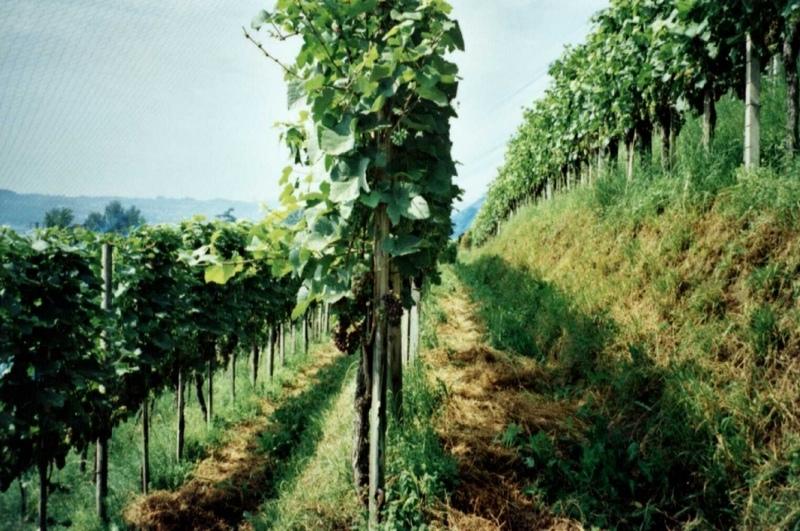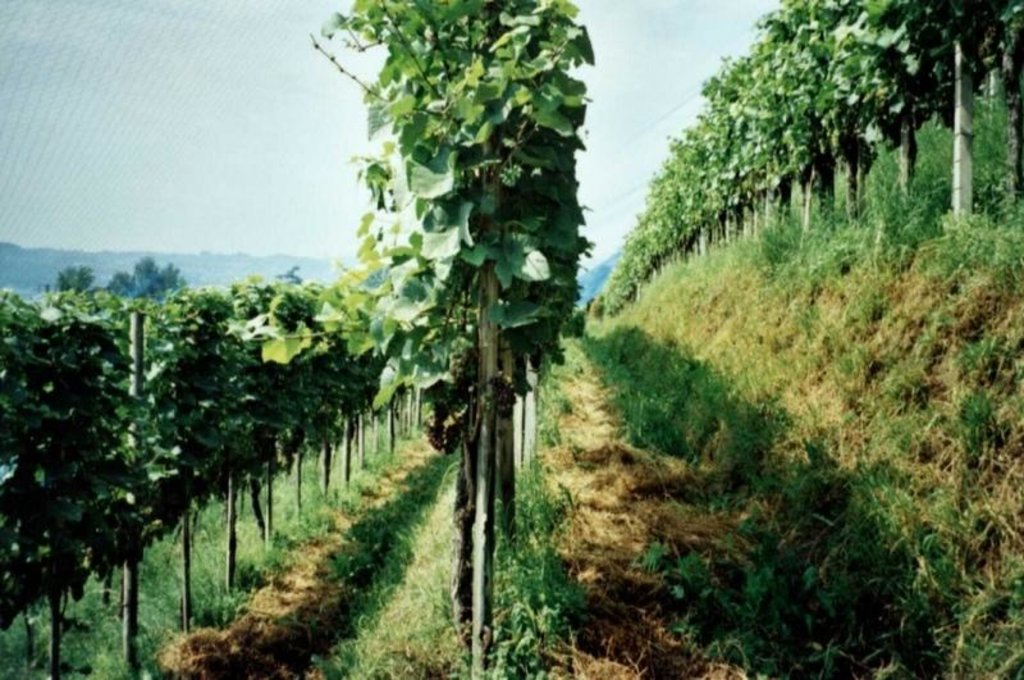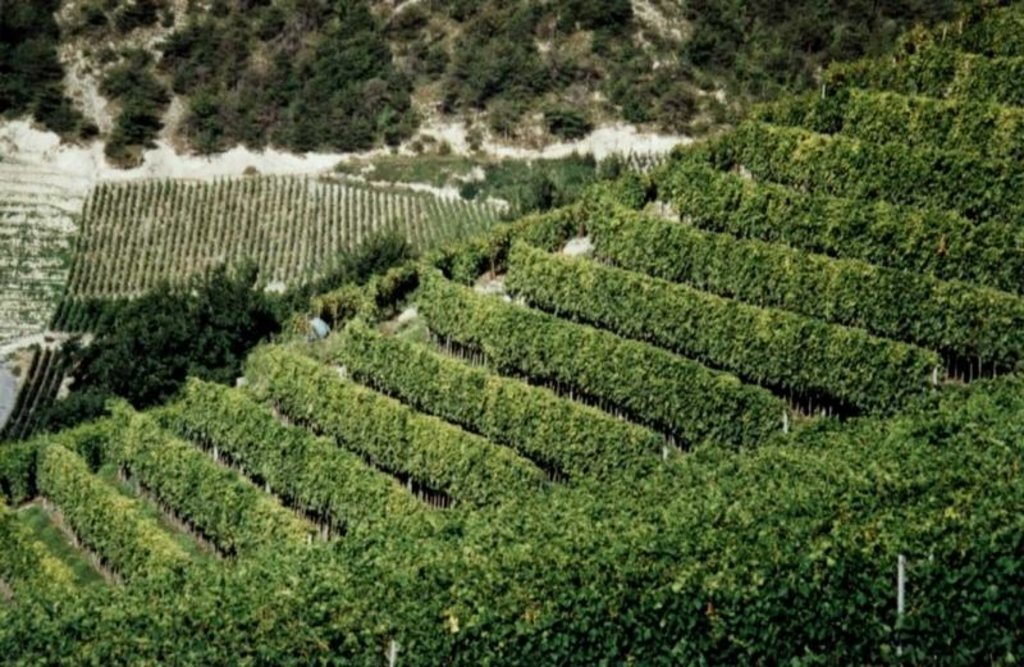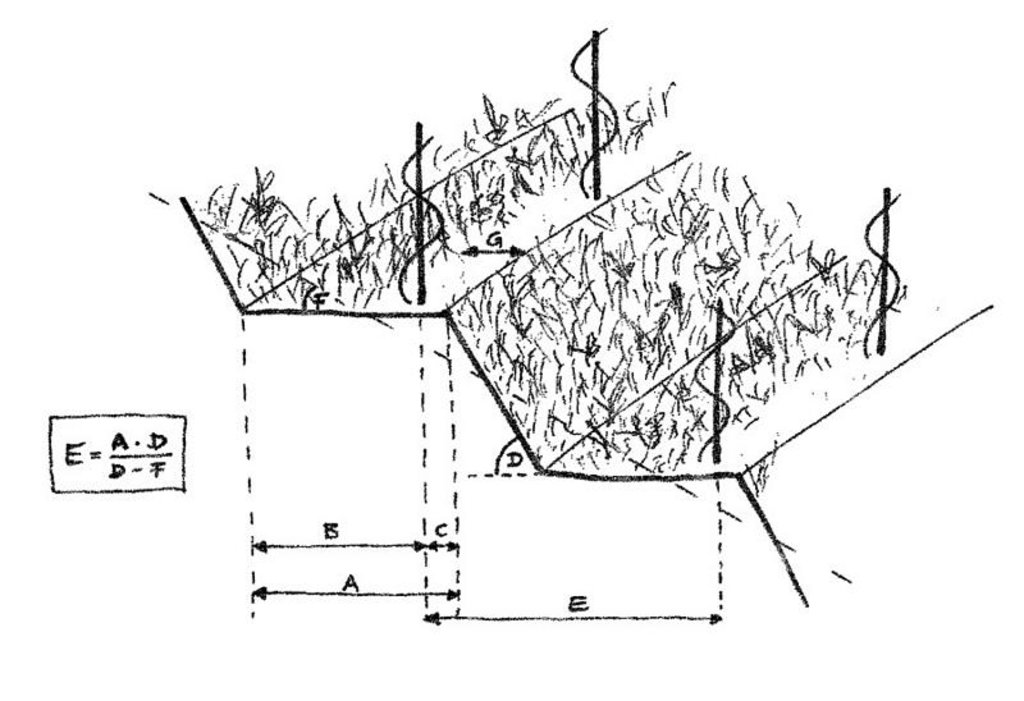Contour small bench terraces with permanent green cover in vineyards [สวิตเซอร์แลนด์]
- ผู้สร้างสรรค์:
- การอัพเดท:
- ผู้รวบรวม: Nicole Guedel
- ผู้เรียบเรียง: –
- ผู้ตรวจสอบ: Fabian Ottiger, Alexandra Gavilano
Ganzjährig begrünte Kleinterrassen im Rebbau
technologies_1011 - สวิตเซอร์แลนด์
ดูส่วนย่อย
ขยายทั้งหมด ย่อทั้งหมด1. ข้อมูลทั่วไป
1.2 รายละเอียดที่ติดต่อได้ของผู้รวบรวมและองค์กรที่เกี่ยวข้องในการประเมินและการจัดเตรียมทำเอกสารของเทคโนโลยี
ผู้เชี่ยวชาญ SLM:
Weissenbach Peter
Federal Research Station for fruit-growing, viticulture and horticulture-FAW
สวิตเซอร์แลนด์
ผู้เชี่ยวชาญ SLM:
Spring Jean-Laurent
Federal Research Station for fruit-growing, viticulture and horticulture-RAC
สวิตเซอร์แลนด์
ผู้ใช้ที่ดิน:
Louis Hannes
Louis Weinbau
สวิตเซอร์แลนด์
ผู้ใช้ที่ดิน:
Hasler Lukas
Hasler Weinbau
สวิตเซอร์แลนด์
ชื่อขององค์กรซึ่งอำนวยความสะดวกในการทำเอกสารหรือการประเมินเทคโนโลยี (ถ้าเกี่ยวข้อง)
Federal Research Station for fruit-growing, viticulture and horticulture (FAW/RAC) - สวิตเซอร์แลนด์ชื่อขององค์กรซึ่งอำนวยความสะดวกในการทำเอกสารหรือการประเมินเทคโนโลยี (ถ้าเกี่ยวข้อง)
CDE Centre for Development and Environment (CDE Centre for Development and Environment) - สวิตเซอร์แลนด์1.3 เงื่อนไขการใช้ข้อมูลที่ได้บันทึกผ่านทาง WOCAT
ผู้รวบรวมและวิทยากรหลักยอมรับเงื่อนไขเกี่ยวกับการใช้ข้อมูลที่ถูกบันทึกผ่านทาง WOCAT:
ใช่
1.5 Reference to Questionnaire(s) on SLM Approaches (documented using WOCAT)
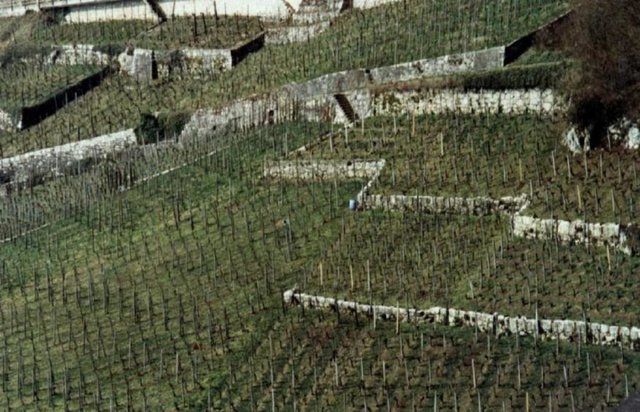
Farmer initiative within enabling environment [สวิตเซอร์แลนด์]
Initiative and innovation of land users, stimulated by government's technical and financial support.
- ผู้รวบรวม: Nicole Guedel
2. การอธิบายลักษณะของเทคโนโลยี SLM
2.1 การอธิบายแบบสั้น ๆ ของเทคโนโลยี
คำจำกัดความของเทคโนโลยี:
Contour small bench terraces with stabilising permanent green cover in steep sloping vineyards.
2.2 การอธิบายแบบละเอียดของเทคโนโลยี
คำอธิบาย:
Description: The vineyards of the region are all, for micro-climatc reasons, more or less sloped. The technology is applied on steep to very steep slopes. It ist characterised by two elements: 1) small bench terrace with one contour-oriented vine row per terrace and 2) an initially sown all-year green cover of the soil surface for stabilisation reasons (green cover is also used between vine rows which are oriented up and down the slope, eg not terraced, see SWI01).
Purpose: Main purpose of the terrace construction is a possible mechanisation on steep to very steep slopes. Direct purpose of the green cover is the stabilisation of the small terraces, indirect but important purpose is the prevention of soil degradation, especially soil erosion by water and - secondary - to protect soil surface from compactation when using mechanised equipment.
Establishment: The terraces are constructed by external specialists and heavy machinery (walking excavator, type "Menzi Muck") and are considered to serve for a whole life cycle of the vine (20-40 years). The green cover is sown since stabilisation is needed from the very beginning on. The duration of the establishment is 3 years. Because of insufficient root length of young vines agronomic and vegetative measures differ from the "normal" measures: For reasons of competition the space around the freshly planted vines is kept free from vegetation with a hoe.
Maintenance: the topsoil is ripped from time to time with fuel driven machine (spade machine tracked by tractor). Cover vegetation is either cut or chopped and serves as mulching . Herbicides are applied around the vines. Minimum tillage and cutting / mulching may additionally serve to mobilise nutrients and to increase organic matter content or to eliminate competition of cover vegetation.
Natural environment: the vineyards are mainly placed on mountain or hill slopes, below 600 m a.s.l., annual rainfall is around 1000 mm with at least one erosive storm per year. The geological underground is limy, locally layered by Molasse (type of conglomerate). Soil properties are strongly influenced by anthropogenic activities (viticulture). Main degradation problem without green cover is erosion by water.
Human environment / land use: the region has a strong wine growing tradition (several centuries), belongs to the important Swiss wine growing regions and is not very densly populated.
First experiments with green cover in Switzerland were done in the 70ies around Zürich on contour small bench terraces, in the region of the lake of Biel contour small bench terraces with green cover started to be implemented in the 80ies
2.3 รูปภาพของเทคโนโลยี
2.5 ประเทศภูมิภาค หรือสถานที่ตั้งที่เทคโนโลยีได้นำไปใช้และได้รับการครอบคลุมโดยการประเมินนี้
ประเทศ:
สวิตเซอร์แลนด์
ภูมิภาค/รัฐ/จังหวัด:
Canton of Berne
ข้อมูลจำเพาะเพิ่มเติมของสถานที่ตั้ง :
Lake of Biel
แสดงความคิดเห็น:
The technology is applied in all winegrowing regions of Switzerland, but under different conditions.
2.6 วันที่การดำเนินการ
ถ้าไม่รู้ปีที่แน่นอน ให้ระบุวันที่โดยประมาณ:
- น้อยกว่า 10 ปี (ไม่นานนี้)
2.7 คำแนะนำของเทคโนโลยี
ให้ระบุว่าเทคโนโลยีถูกแนะนำเข้ามาอย่างไร:
- ทางโครงการหรือจากภายนอก
ความคิดเห็น (ประเภทของโครงการ เป็นต้น) :
The development of contour small bench terraces with green cover in vineyards was (also on the international level) essentially promoted and supported by the Federal Research Station for fruit-growing, viticulture and horticulture in Wädenswil (Canton of Zürich) and Changins (Canton of Vaud)
3. การจัดประเภทของเทคโนโลยี SLM
3.2 ประเภทของการใช้ที่ดินในปัจจุบันที่ได้นำเทคโนโลยีไปใช้

พื้นที่ปลูกพืช
- การปลูกไม้ยืนต้น ไม้พุ่ม
Tree and shrub cropping - Specify crops:
- grapes
จำนวนของฤดูเพาะปลูกต่อปี:
- 1
ระบุ:
Longest growing period in days: 210Longest growing period from month to month: Apr - Oct
แสดงความคิดเห็น:
Major land use problems (compiler’s opinion): The main problem was decreasing soil fertility, especially throug soil erosion by water with negative off-site effects like sand- /sediment deposition and contamination of groundwater by nutrients. It became a serious problem since the 60ies when the fact became visible that the traditional labour-intensive cultivation system, which was strongly dependent on external inputss, could no longer be sustained within an industrialised agriculture system.
Type of cropping system and major crops comments: a vine plantation is established for a period of 20-40 years (lifetime of a vine). Some farmers make one year of fallow between the destruction of the old and the establishment of a new plantation.
3.4 การใช้น้ำ
การใช้น้ำของที่ดินที่มีการใช้เทคโนโลยีอยู่:
- น้ำฝนร่วมกับการชลประทาน
แสดงความคิดเห็น:
Water supply: rainfed, mixed rainfed - irrigated
3.5 กลุ่ม SLM ที่ตรงกับเทคโนโลยีนี้
- การปรับปรุงดิน / พืชคลุมดิน
- มาตรการปลูกพืชขวางความลาดชัน (cross-slope measure)
- Stabilisation of terraces
3.6 มาตรการ SLM ที่ประกอบกันเป็นเทคโนโลยี
3.7 รูปแบบหลักของการเสื่อมโทรมของที่ดินที่ได้รับการแก้ไขโดยเทคโนโลยี

การกัดกร่อนของดินโดยน้ำ
- Wt (Loss of topsoil): การสูญเสียดินชั้นบนหรือการกัดกร่อนที่ผิวดิน
- Wo (Offsite degradation): ผลกระทบนอกพื้นที่

การเสื่อมโทรมของดินทางด้านเคมี
- Cn (Fertility decline): ความอุดมสมบูรณ์และปริมาณอินทรียวัตถุในดินถูกทำให้ลดลงไป (ไม่ได้เกิดจากสาเหตุการกัดกร่อน)
- Cp (Soil pollution): มลพิษในดิน

การเสื่อมโทรมของดินทางด้านกายภาพ
- Pc (Compaction): การอัดแน่น
- Pk (Slaking and crusting): การอุดตันของช่องว่างในดินหรือรูพรุน
แสดงความคิดเห็น:
Main type of degradation addressed: Wt: loss of topsoil / surface erosion, Wo: offsite degradation effects
Secondary types of degradation addressed: Cn: fertility decline and reduced organic matter content, Cp: soil pollution, Pc: compaction, Pk: sealing and crusting
Main causes of degradation: other human induced causes (specify) (agricultural causes: fast changing basic conditions of viticulture in the last 100 years), education, access to knowledge and support services (lack of knowledge), fast changing basic conditions of viticulture (economy, laws)
3.8 การป้องกัน การลดลง หรือการฟื้นฟูความเสื่อมโทรมของที่ดิน
ระบุเป้าหมายของเทคโนโลยีกับความเสื่อมโทรมของที่ดิน:
- ลดความเสื่อมโทรมของดิน
แสดงความคิดเห็น:
Main goals: mitigation / reduction of land degradation
4. ข้อมูลจำเพาะด้านเทคนิค กิจกรรมการนำไปปฏิบัติใช้ ปัจจัยนำเข้า และค่าใช้จ่าย
4.1 แบบแปลนทางเทคนิคของเทคโนโลยี
ข้อมูลจำเพาะด้านเทคนิค (แบบแปลนทางเทคนิคของเทคโนโลยี):
Technical drawing of small contour bench terraces with permanent green cover. A = width of terrace, B = tractor area, C = distance between vine plant and terrace edge, D = gradient of terrace riser, E = distance of vine rows, F = orignal slope, G = zone of application of herbicides (10-40 cm).
Date: June 2003
Technical knowledge required for field staff / advisors: high
Technical knowledge required for land users: moderate
Main technical functions: control of dispersed runoff: retain / trap, reduction of slope angle, reduction of slope length, improvement of ground cover
Secondary technical functions: control of raindrop splash, increase of surface roughness, increase in organic matter, increase of infiltration, increase / maintain water stored in soil, improvement of soil structure, increase in soil fertility
Mulching
Material/ species: cut or chopped cover vegetation
Remarks: dispersed over the whole surface; if possible cutting/chopping (alternating)
Agronomic measure: removing less vegetation cover
Material/ species: cut or chopped cover vegetation, vine leaves and cut branches
Remarks: between vine rows
Manure / compost / residues
Material/ species: compost
Remarks: only sporadically (every 5-10 year or less)
Mineral (inorganic) fertilizers
Material/ species: nitrogen
Quantity/ density: 0-50 kg/ha
Remarks: normally rather little nitrogen
Agronomic measure: mineral (inorganic) fertilizers
Material/ species: potassium
Quantity/ density: 0-20 kg/ha
Agronomic measure: mineral (inorganic) fertilizers
Material/ species: magnesium
Quantity/ density: 0-25 kg/ha
Agronomic measure: mineral (inorganic) fertilizers
Material/ species: phosphorus
Quantity/ density: 0-20 kg/ha
Breaking compacted subsoil
Remarks: only on terrace, if possible only every second row/terrace (alternating)
Scattered / dispersed
Vegetative material: G : grass
Grass species: different grass species, taraxacum, veronica, legumes, calystegia, geranium...
Terrace: bench level
Vertical interval between structures (m): 1.3 m
Spacing between structures (m): 2.5 m
Construction material (earth): only earth of parcel
Slope (which determines the spacing indicated above): 60%
Lateral gradient along the structure: 0%
Vegetation is used for stabilisation of structures.
ผู้เขียน:
Nicole Güdel, Berne, Switzerland
4.3 กิจกรรมเพื่อการจัดตั้ง
| กิจกรรม | Timing (season) | |
|---|---|---|
| 1. | sowing cover vegetation on the terrace riser (for stabilisation) (nonrecurring) | winter/spring, usually at the same time as a new plantation is established |
| 2. | letting grow natural cover vegetation on terrace (nonrecurring) | winter/spring, usually at the same time as a new plantation is established |
| 3. | Removing vegetation around vines (diameter of vegetation-free zone: 10 - 40 cm) | during season (Mai – October), 2 - 4 times, when necessary. |
| 4. | removing old vines | winter/spring |
| 5. | deep tillage | winter/spring |
| 6. | construction of terraces | winter/spring |
| 7. | support of construction of terraces | winter/spring |
4.4 ค่าใช้จ่ายของปัจจัยนำเข้าที่จำเป็นสำหรับการจัดตั้ง
แสดงความคิดเห็น:
Duration of establishment phase: 36 month(s)
4.5 การบำรุงรักษาสภาพหรือกิจกรรมที่เกิดขึ้นเป็นประจำ
| กิจกรรม | ช่วงระยะเวลา/ความถี่ | |
|---|---|---|
| 1. | cuting and not removing vine leaves and branches | winter / annual |
| 2. | fertilising (mineral or manure/compost) | April/May / annual |
| 3. | cutting / chopping and then mulcihng cover vegetation | during cropping season (first time April/May) / each row 2-4 times during cropping season |
| 4. | cuting and not removing vine leaves and branches | during cropping season / several times during cropping season |
| 5. | breaking compacted topsoil | April/May / each row every 4-8 years |
| 6. | application of herbicides (glyphosates) | beginning of season (May), if necessary second time in Aug./Sept /once (if necessary twice) during s |
| 7. | putting back earth which war fallen from the terrace riser to the terrace | winter/spring/if necessary |
| 8. | slightly reshaping terraces | winter/spring/if necessary |
4.6 ค่าใช้จ่ายของปัจจัยนำเข้าและกิจกรรมที่เกิดขึ้นเป็นประจำที่ต้องการการบำรุงรักษา (ต่อปี)
แสดงความคิดเห็น:
Machinery/ tools: e.g.: walking excavator, hoe, mower with tracked vehicle or portable motor scythe, spading machine with tracked vehicle; knapsack sprayer or biocide t
4.7 ปัจจัยสำคัญที่สุดที่มีผลกระทบต่อค่าใช้จ่าย
ปัจจัยสำคัญที่สุดที่มีผลกระทบต่อค่าใช้จ่ายต่างๆ:
(manual) labour
5. สิ่งแวดล้อมทางธรรมชาติและของมนุษย์
5.1 ภูมิอากาศ
ฝนประจำปี
- < 250 ม.ม.
- 251-500 ม.ม.
- 501-750 ม.ม.
- 751-1,000 ม.ม.
- 1,001-1,500 ม.ม.
- 1,501-2,000 ม.ม.
- 2,001-3,000 ม.ม.
- 3,001-4,000 ม.ม.
- > 4,000 ม.ม.
ข้อมูลจำเพาะ/ความคิดเห็นเรื่องปริมาณน้ำฝน:
Average: Biel: 1200 mm. Region of Bielersee: 1000 - 1200 mm. Neuchâtel: 930 mm.
เขตภูมิอากาศเกษตร
- กึ่งชุ่มชื้น
Thermal climate class: temperate
5.2 สภาพภูมิประเทศ
ค่าเฉลี่ยความลาดชัน:
- ราบเรียบ (0-2%)
- ลาดที่ไม่ชัน (3-5%)
- ปานกลาง (6-10%)
- เป็นลูกคลื่น (11-15%)
- เป็นเนิน (16-30%)
- ชัน (31-60%)
- ชันมาก (>60%)
ธรณีสัณฐาน:
- ที่ราบสูง/ที่ราบ
- สันเขา
- ไหล่เขา
- ไหล่เนินเขา
- ตีนเนิน
- หุบเขา
ระดับความสูง:
- 0-100 เมตร
- 101-500 เมตร
- 501-1,000 เมตร
- 1,001-1,500 เมตร
- 1,501-2,000 เมตร
- 2,001-2,500 เมตร
- 2,501-3,000 เมตร
- 3,001-4,000 เมตร
- > 4,000 เมตร
ความคิดเห็นและข้อมูลจำเพาะเพิ่มเติมเรื่องสภาพภูมิประเทศ:
Altitudinal zone: 501-1000 m a.s.l. (For climatic reasons vines grow hardly above 600 m a.s.l. in Switzerland)
Landforms: Hill slopes (most of them southeastward sloping hills (part of the Jura mountain range))
Slopes on average: Steep (31-60%) (Vines are planted on different slopes. But contour small bench terraces are applied at steep slopes)
5.3 ดิน
ค่าเฉลี่ยความลึกของดิน:
- ตื้นมาก (0-20 ซ.ม.)
- ตื้น (21-50 ซ.ม.)
- ลึกปานกลาง (51-80 ซ.ม.)
- ลึก (81-120 ซ.ม.)
- ลึกมาก (>120 ซ.ม.)
เนื้อดิน (ดินชั้นบน):
- ปานกลาง (ดินร่วน ทรายแป้ง)
อินทรียวัตถุในดิน:
- ปานกลาง (1-3%)
(ถ้ามี) ให้แนบคำอธิบายเรื่องดินแบบเต็มหรือระบุข้อมูลที่มีอยู่ เช่น ชนิดของดิน ค่า pH ของดินหรือความเป็นกรดของดิน ความสามารถในการแลกเปลี่ยนประจุบวก ไนโตรเจน ความเค็ม เป็นต้น:
Soil depth: From shallow to very deep (Soil depth is very irregular, at some places limestone rocks appear at the surface, at other places soil can be quite deep.But if soil is very shallow for the whole parcel contour small bench terraces)
Soil fertilits is medium (Vines are normally grown on rather marginal spots. Compared to the general productivity these soils have a medium fertility. (If measured at the vine itself, soil fertility is sufficient/high))
Topsoil organic matter is medium (loamy,silty) (without / before SWC (green cover))
Soil drainage/infiltration is mostly good, at some spots medium (depressions; when high percentage of clay)
Soil water storage capacity is medium (without / before SWC (green cover)), high (without / before SWC (green cover)) or low (without / before SWC (green cover). Depressions; when high percentage of clay)
5.6 ลักษณะของผู้ใช้ที่ดินที่นำเทคโนโลยีไปปฏิบัติใช้
แนวทางการตลาดของระบบการผลิต:
- ทำการค้า/การตลาด
รายได้ที่มาจากนอกฟาร์ม:
- < 10% ของรายได้ทั้งหมด
ระดับของความมั่งคั่งโดยเปรียบเทียบ:
- พอมีพอกิน
ระดับของการใช้เครื่องจักรกล:
- งานที่ใช้แรงกาย
- การใช้เครื่องจักรหรือเครื่องยนต์
ระบุลักษณะอื่นๆที่เกี่ยวข้องของผู้ใช้ที่ดิน:
Population density: 200-500 persons/km2
Annual population growth: 0.5% - 1%
Off-farm income specification: This is representative for the full time winegrowers. The majority of winegrowers do winegrowing beside a regular off-farm job as a hobby. Nearly all winegrowers have implementeted the SWC technology. Probably there is no difference in hobby-winegrowers and full-time-winegrowers concernring implementation of the SWC technology.
Level of mechanization: Manual labour (most of the work in the vineyard is done by hand (especially harvest)) or mechanised (some of the activities are carried out with fuel driven equipment. But mechanisation is moderate since big and heavy machines cannot been applied in these vineyards).
Market orientation is commercial/market (in the region of the lake of Biel the majority of grapes are pressed to wine an then and sold directly from the farm's wine cellar)
5.7 Average area of land used by land users applying the Technology
- < 0.5 เฮกตาร์
- 0.5-1 เฮกตาร์
- 1-2 เฮกตาร์
- 2-5 เฮกตาร์
- 5-15 เฮกตาร์
- 15-50 เฮกตาร์
- 50-100 เฮกตาร์
- 100-500 เฮกตาร์
- 500-1,000 เฮกตาร์
- 1,000-10,000 เฮกตาร์
- >10,000 เฮกตาร์
แสดงความคิดเห็น:
Average area of land owned or leased by land users applying the Technology: 0.5-1 ha, 1-2 ha, 2-5 ha, 5-15 ha (only winegrowing land!)
5.8 กรรมสิทธิ์ในที่ดิน สิทธิในการใช้ที่ดินและสิทธิในการใช้น้ำ
กรรมสิทธิ์ในที่ดิน:
- รายบุคคล ได้รับสิทธิครอบครอง
สิทธิในการใช้ที่ดิน:
- รายบุคคล
6. ผลกระทบและสรุปคำบอกกล่าว
6.1 ผลกระทบในพื้นที่ดำเนินการ (On-site) จากการใช้เทคโนโลยี
ผลกระทบทางด้านเศรษฐกิจและสังคม
การผลิต
การผลิตพืชผล
แสดงความคิดเห็น/ระบุ:
maximum production capacity is reduced due to 1. Plantation density is smaller and 2. Capacity per vine is reduced due to slight competition of water and nutrients, intensified in the terrace riser under dry conditions
คุณภาพพืชผล
แสดงความคิดเห็น/ระบุ:
Reduced quality of wine occurs when strong competition of water and nutrients happen and nothing is done against it.
การเสี่ยงต่อความล้มเหลวในการผลิต
แสดงความคิดเห็น/ระบุ:
Higher susceptibility to fungal decay due to higher evapotranspiration rate with green cover and therefore humid microclimatic conditions. Other problems are competition over water and nutrients or danger of frost - negligible - only in depressions or plains (due to higher evapotranspiration rate)
รายได้และค่าใช้จ่าย
รายได้จากฟาร์ม
แสดงความคิดเห็น/ระบุ:
Primarily due to less costs, especially resulting from less erosion damages in the long term (because of green cover). Secondary due to marketing argument "ecological agricultural production", subsidies related to green cover (direct payment which is only
ภาระงาน
แสดงความคิดเห็น/ระบุ:
More and specific knowledge necessary
ผลกระทบทางด้านเศรษฐกิจและสังคมอื่น ๆ
Inputs for mechanisation
แสดงความคิดเห็น/ระบุ:
Special machines needed, mechanisation is almost a must to be economically successful in the long term
ผลกระทบด้านสังคมวัฒนธรรมอื่น ๆ
สถานการณ์ด้านสุขภาพ
แสดงความคิดเห็น/ระบุ:
Healthier than without SWC, less application of biocides and more comfortable and healty posture of body.
สถาบันของชุมชน
แสดงความคิดเห็น/ระบุ:
Increased exchange of knowledge and contacts in winegrowers society
สถาบันแห่งชาติ
แสดงความคิดเห็น/ระบุ:
Research stations gained new knowledge and attention
SLM หรือความรู้เรื่องความเสื่อมโทรมของที่ดิน
แสดงความคิดเห็น/ระบุ:
Among winegrowers, but perhaps also slightly among consumers (through an ecological marketing argument) or walkers (walking through a green vineyard may arise interest in green cover).
การบรรเทาความขัดแย้ง
แสดงความคิดเห็น/ระบุ:
Between generations or between farmers applying green cover and others. Reason: farmers are differently attached to traditional values and norms (i.e.: traditionally every plant was seen as unuseful weed and fought with a hoe).
Personal satisfaction / challenge
แสดงความคิดเห็น/ระบุ:
Many farmers apply green cover see green cover as a personal satisfaction or challenge for an ecologically and economically sustainable viticulture
Acceptance by society
แสดงความคิดเห็น/ระบุ:
Landscape and appearance of Landscape & appearance of vineyard as cultural heritage. Different values an norms of "how a vineyard should look like". Traditionally vines were planted very dense with no vegetation cover in between. Contour small bench terraces are quite new to the area (20-30 years)
ผลกระทบด้านนิเวศวิทยา
ดิน
ความชื้นในดิน
แสดงความคิดเห็น/ระบุ:
Especially through improved water retention capacity (due to improved soil structure)
สิ่งปกคลุมดิน
การสูญเสียดิน
แสดงความคิดเห็น/ระบุ:
Mainly due to green cover (rather than terraces)
การอัดแน่นของดิน
ความหลากหลายทางชีวภาพของพืชและสัตว์
พืชพันธุ์ต่างถิ่นที่รุกล้ำเข้ามา
แสดงความคิดเห็น/ระบุ:
Undesirable plant and animal species (i.e. mice (can hamper stability of terrace riser and terrace itself))
การจัดการศัตรูพืชและโรคพืช
แสดงความคิดเห็น/ระบุ:
Through beneficial animals
ลดความเสี่ยงของภัยพิบัติ
ความเร็วของลม
ผลกระทบด้านนิเวศวิทยาอื่น ๆ
Biodiversity
แสดงความคิดเห็น/ระบุ:
High diversity due to different habitats (extensively managed terrace riser and terrace)
Soil fertility
6.2 ผลกระทบนอกพื้นที่ดำเนินการ (Off-site) จากการใช้เทคโนโลยี
น้ำท่วมพื้นที่ท้ายน้ำ
การทับถมของดินตะกอนพื้นที่ท้ายน้ำ
การเกิดมลพิษในน้ำบาดาลหรือแม่น้ำ
ตะกอนที่ถูกพัดพามาโดยลม
6.4 การวิเคราะห์ค่าใช้จ่ายและผลประโยชน์ที่ได้รับ
ผลประโยชน์ที่ได้รับเปรียบเทียบกับค่าใช้จ่ายในการจัดตั้งเป็นอย่างไร (จากมุมมองของผู้ใช้ที่ดิน)
ผลตอบแทนระยะสั้น:
ด้านลบอย่างมาก
ผลตอบแทนระยะยาว:
เป็นกลางหรือสมดุล
ผลประโยชน์ที่ได้รับเปรียบเทียบกับค่าใช้จ่ายในการบำรุงรักษาหรือต้นทุนที่เกิดขึ้นซ้ำอีก เป็นอย่างไร (จากมุมมองของผู้ใช้ที่ดิน)
ผลตอบแทนระยะสั้น:
ด้านลบเล็กน้อย
ผลตอบแทนระยะยาว:
เป็นกลางหรือสมดุล
6.5 การปรับตัวของเทคโนโลยี
Of all those who have adopted the Technology, how many did so spontaneously, i.e. without receiving any material incentives/ payments?
- 91-100%
แสดงความคิดเห็น:
10% of land user families have adopted the Technology with external material support
Comments on acceptance with external material support: estimates
90% of land user families have adopted the Technology without any external material support
Comments on spontaneous adoption: estimates
There is a strong trend towards spontaneous adoption of the Technology
Comments on adoption trend: Contour small bench terraces with green cover are seen as good opportunity for viticulture in steep slopes. Adoption is done mainly spontaneous
7. การอ้างอิงและการเชื่อมต่อ
7.1 วิธีการและแหล่งข้อมูล
ลิงก์และโมดูล
ขยายทั้งหมด ย่อทั้งหมดลิงก์

Farmer initiative within enabling environment [สวิตเซอร์แลนด์]
Initiative and innovation of land users, stimulated by government's technical and financial support.
- ผู้รวบรวม: Nicole Guedel
โมดูล
ไม่มีโมดูล


